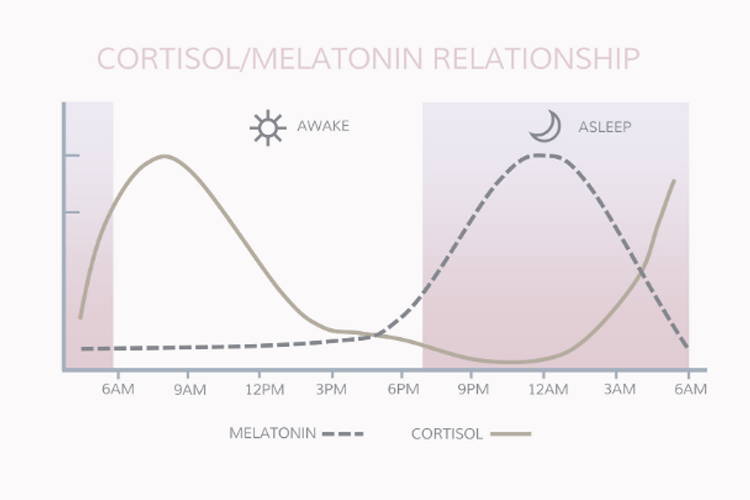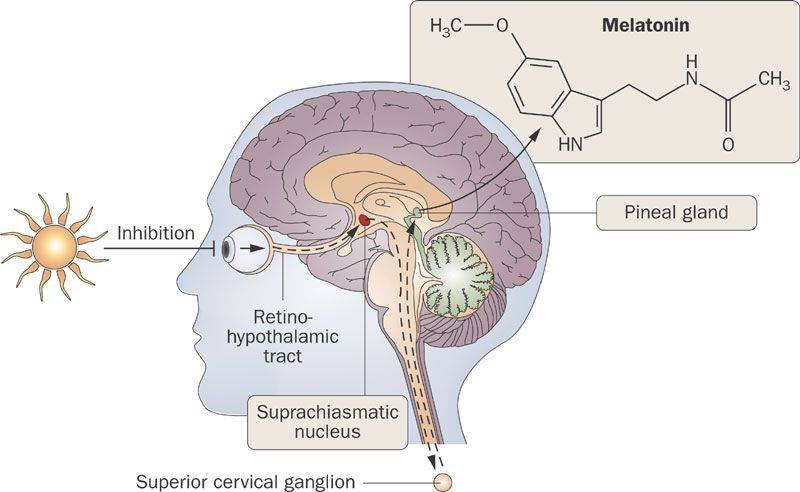The Science Behind Waking With Light
Exposure to light early in the morning is one of the key environmental signals for setting our circadian rhythms and is often an overlooked factor when it comes to addressing common sleep issues. With the correct quality and timing of early morning light exposure, ideally upon waking up, many of these problems can be alleviated.
Andrew Huberman - PhD, associate professor of neurobiology and of ophthalmology: "Light is one of the most effective tools we have for setting our circadian clocks. If we’re in a dark room when we wake up, there isn’t enough light to trigger the correct timing of the hormones cortisol and melatonin, which are not only crucial for sleep quality but also for helping us feel alert and energised upon waking."
The health benefits of waking with light are well documented in peer-reviewed journals. The research covers many areas from sleep, cardiac function, energy upon waking, cognitive function and more.
What Is The Sleep-Wake Cycle?
The sleep-wake cycle, otherwise known as your biological clock, is a daily pattern which determines when your body wants to wake up and when it wants to go to sleep. Most people will on average be awake for 16 hours, followed by 8 hours of sleep. This pattern is why you will wake up on your own without an alarm clock.
Your sleep-wake cycle is regulated by your circadian rhythm which not only controls our sleep patterns, but also governs many other important bodily functions, including our metabolism, body temperature, hormone production, digestion, blood sugar levels and more.
The Problem With Most Sleep Patterns
As a result of modern day living, our exposure to light has become very disjointed and out of touch with the natural rise and fall of the sun. Everything from bright artificial lights late at night, to lack of sun exposure throughout the day due to indoor living, glass windows and glasses, or just living through a UK winter. This disrupts our circadian rhythms and reduces the body's ability to function optimally.
Most of the time our sleep does not align with sunrise, especially in the dark winter months. Therefore, we generally wake up in a dark environment and our body does not effectively trigger the release of certain hormones when waking. This leaves us feeling not ready to start the day, whilst also impacting our ability to sleep well the next day.
When we wake up in the morning, it’s because two particular hormones called Cortisol and Epinephrine (adrenaline) are released from our Adrenal Glands in a pulse. The pulse of Cortisol and Adrenaline causes us to be awake and feel alert. Releasing the whole pulse of these hormones is important so that the body has enough energy to perform all its necessary functions throughout the day.
However, these two hormones not only trigger our wake up, but also play a more crucial role for sleep. A healthy release of the morning hormones sets an internal timer which signals the production of Melatonin. This sleep hormone is responsible for making us feel sleepy later on in the day. When our body does not produce enough melatonin at the correct time, falling asleep can be very difficult and one may experience more interrupted sleep.

Morning light triggers the production of Cortisol and Epinephrine
In short, the sleep-wake cycle is a result of releasing the correct hormones in a healthy amount at the right time.
The production of Cortisol, which starts the cycle, is triggered largely by external factors. Light being one of the most powerful environmental signals for the initiation of this cycle, which sends a signal to the Suprachiasmatic Nucleus, responsible for controlling the morning pulse of Cortisol. However, as most of our schedules do not naturally align with sunrise, the brain does not receive a strong or consistent trigger for the morning pulse of hormones.
Simulating Sunrise With Rowland Earthclock™
The good news is that morning light, ideally upon waking, is one of the strongest environmental triggers for setting our circadian rhythms.
Whilst sunlight is the the optimal form of light in the morning, it is not always possible to get exposure to sunlight. Even through a window, sunlight is up to 50 times less effective when the light hits the back of the retina in our eyes. Many people also set their alarms before sunrise, which does not give them the chance to experience high quality light exposure upon waking.
The Rowland EarthClock™ uses specific wavelengths of light that aims to replicate a natural sunrise. This offers the opportunity for people to reconnect with nature in the modern world where it is not always easy or possible. It also ensures that your body produces enough Cortisol and Epinephrine at the time you wake up, which keeps your circadian rhythm strong and functioning well.
However, it is still always recommended to get outside soon after waking up to expose your eyes to even more brightness and further strengthen your circadian rhythm.
The following image shows how light initiates the trigger of Cortisol and Melatonin, by signalling the Suprachiasmatic.
Image taken from: The Science of Sleep - American Chemical Society

Dr Huberman explains "It’s all to do with the chemical reactions that happen from being exposed to light, namely the rise and fall of cortisol and melatonin. There’s a healthy rising tide of cortisol that happens early in the day… it makes you feel alert, it makes you feel able to move and want to move throughout your day for work for exercise, school, social relations, etc. But it also sets off a timer in your nervous system that dictates when a different hormone, called melatonin, which makes you sleepy, will be secreted".
Study: Using Light To Re-set Circadian Rhythms
A study in night shift workers and pilots who both struggle with getting light at the right time as a result of their job. Both situations produce a misalignment between circadian rhythms and the new sleep/wake schedule, resulting in a constellation of symptoms such as sleepiness, decreased alertness, impaired performance, difficulty initiating and maintaining sleep. Constantly changing time zone or working at night meant that these groups could not rely on sunlight, and the study therefore incorporated the use artificial light.
The results of the study demonstrated that jet lag could in fact be prevented entirely if rhythms are shifted before the flight using their preflight plan. The study also concluded that it is possible to reset your sleep pattern with the use of artificial light. You can view the full study here - https://pubmed.ncbi.nlm.nih.gov/16077154/
Waking With Light Instead Of Sound
Using light to wake has numerous benefits that are not be achievable with a standard sound alarm clock. Light not only creates a more natural and pleasant wake-up experience, but light also triggers Cortisol and Epinephrine upon waking, as well as establishing healthy circadian rhythms, something which sound alone unfortunately is not able to achieve.
As a natural byeproduct of this, there are a number of scientifically proven benefits, including; forming healthier sleep patterns, improved sleep quality, greater ease falling asleep and waking up, improved mood and energy, improved cardiac and cognitive function, more alertness upon waking and more.
The Rowland EarthClock™ has been designed to create an upgraded waking up experience that has wider benefits than just being woken up for a certain time.
If you have any questions or would like to share any new science with us, please get in touch with our customer support team at support@rowlandearthing.co.uk
Published Papers and Studies:
How to trick mother nature into letting you fly around or stay up all night
Victoria L Revell, Charmane I Eastman
Night shift work and rapid transmeridian travel result in a misalignment between circadian rhythms...
Delayed sleep-wake phase disorder
Ontogeny of Circadian Rhythms and Synchrony in the Suprachiasmatic Nucleus
Vania Carmona-Alcocer, John H. Abel, Tao C. Sun, Linda R. Petzold, Francis J. Doyle III, Carrie L. Simms and Erik D. Herzog
In mammals, the suprachiasmatic nucleus (SCN) of the hypothalamus coordinates daily rhythms including sleep–wake...
The effects of light therapy on sleep problems: A systematic review and meta-analysis
Annette van Maanen, Anne Marie Meijer, Kristiaan B van der Heijden, Frans J Oort
This meta-analysis is the first to systematically review the effect of light therapy on sleep problems in general and on specific...
Cognitive Behavioral Therapy as an Adjunct Treatment to Light Therapy for Delayed Sleep Phase Disorder in Young Adults: A Randomized Controlled Feasibility Study
Katarina Danielsson, Markus Jansson-Fröjmark, Jan-Erik Broman, Agneta Markström
Delayed sleep phase disorder (DSPD) is common among young people, but there is still no...
Phase advancing human circadian rhythms with morning bright light, afternoon melatonin, and gradually shifted sleep: can we reduce morning bright-light duration?
Stephanie J Crowley, Charmane I Eastman
Efficient treatments to phase-advance human circadian rhythms are needed to attenuate circadian misalignment...
The effects of chronotype, sleep schedule and light/dark pattern exposures on circadian phase
Mariana G Figueiro, Barbara Plitnick, Mark S Rea
Chronotype characterizes individual differences in sleep/wake rhythm timing, which can also impact light...
The Effectiveness of Light/Dark Exposure to Treat Insomnia in Female Nurses Undertaking Shift Work during the Evening/Night Shift
Li-Bi Huang, B.S., Mei-Chu Tsai, M.S., Ching-Yen Chen, M.D., and Shih-Chieh Hsu, M.D.
The present study investigated whether bright light exposure during the first half of the evening/night shift combined...
Treatment of circadian rhythm sleep disorders with light
Joshua J Gooley
The human circadian system is normally synchronised with the solar day, insuring that alertness and performance peak...
Melatonin marks circadian phase position and resets the endogenous circadian pacemaker in humans
A J Lewy, R L Sack, M L Blood, V K Bauer, N L Cutler, K H Thomas
Measuring the dim light melatonin onset (DLMO) is a useful and practical way to assess circadian phase position...
